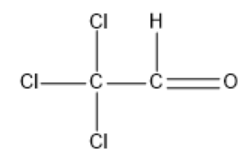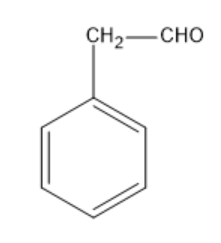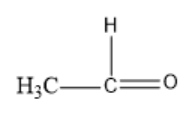
Aldol condensation will not be observed in?
A.Chloral
B.Phenyl acetaldehyde
C.Hexanal
D.Ethanal
Answer
489.3k+ views
Hint: Aldol is the combination of aldehydes and alcohol. The aldol condensation is characterized by the reaction between an aldehyde or ketone with a dilute base. The only important thing is that the aldehyde or ketone should contain an $\alpha -Hydrogen$ atom.
Complete answer:
We know that $\alpha$ hydrogen is the hydrogen present in the carbon atom that is attached to the carbonyl carbon. Now, let us see which compound does not have $\alpha$ hydrogen.
Option A: Chloral
Chloral is also referred to as trichloroacetaldehyde or trichloroethanal. The molecular formula for chloral is $C{{l}_{3}}CCHO$.
Its structural formula is given by:

In the above structure, we can observe that the carbon next to the carbonyl carbon does not have any $\alpha $hydrogen. So, this compound cannot undergo an Aldol condensation reaction.
Option B: Phenyl acetaldehyde
Phenyl acetaldehyde has the molecular formula of ${{C}_{6}}{{H}_{5}}C{{H}_{2}}CHO$.
Its structural formula is given by:

In the above structure, we can observe that the carbon next to the carbonyl carbon has $\alpha $hydrogen. So, this compound can undergo an Aldol condensation reaction.
Option C: Hexanal
The molecular formula of Hexanal is $C{{H}_{3}}C{{H}_{2}}C{{H}_{2}}C{{H}_{2}}C{{H}_{2}}CHO$.
Its structural formula is given by:

In the above structure, we can observe that the carbon next to the carbonyl carbon has $\alpha $hydrogen. So, this compound can undergo an Aldol condensation reaction.
Option D: Ethanal
The molecular formula of Hexanal is $C{{H}_{3}}CHO$.
Its structural formula is given by:

In the above structure, we can observe that the carbon next to the carbonyl carbon has $\alpha $hydrogen. So, this compound can undergo an Aldol condensation reaction.
Final answer: The correct answer is Option A: Chloral.
Note:
Aldol condensation will not be possible if the $\alpha $hydrogen is absent. Because in Aldol condensation, the $\alpha $ hydrogen attacks the carbonyl carbon to form an $\beta $ Unsaturated carbonyl compound. It is favoured by the loss of water molecules from both reactants.
Complete answer:
We know that $\alpha$ hydrogen is the hydrogen present in the carbon atom that is attached to the carbonyl carbon. Now, let us see which compound does not have $\alpha$ hydrogen.
Option A: Chloral
Chloral is also referred to as trichloroacetaldehyde or trichloroethanal. The molecular formula for chloral is $C{{l}_{3}}CCHO$.
Its structural formula is given by:

In the above structure, we can observe that the carbon next to the carbonyl carbon does not have any $\alpha $hydrogen. So, this compound cannot undergo an Aldol condensation reaction.
Option B: Phenyl acetaldehyde
Phenyl acetaldehyde has the molecular formula of ${{C}_{6}}{{H}_{5}}C{{H}_{2}}CHO$.
Its structural formula is given by:

In the above structure, we can observe that the carbon next to the carbonyl carbon has $\alpha $hydrogen. So, this compound can undergo an Aldol condensation reaction.
Option C: Hexanal
The molecular formula of Hexanal is $C{{H}_{3}}C{{H}_{2}}C{{H}_{2}}C{{H}_{2}}C{{H}_{2}}CHO$.
Its structural formula is given by:

In the above structure, we can observe that the carbon next to the carbonyl carbon has $\alpha $hydrogen. So, this compound can undergo an Aldol condensation reaction.
Option D: Ethanal
The molecular formula of Hexanal is $C{{H}_{3}}CHO$.
Its structural formula is given by:

In the above structure, we can observe that the carbon next to the carbonyl carbon has $\alpha $hydrogen. So, this compound can undergo an Aldol condensation reaction.
Final answer: The correct answer is Option A: Chloral.
Note:
Aldol condensation will not be possible if the $\alpha $hydrogen is absent. Because in Aldol condensation, the $\alpha $ hydrogen attacks the carbonyl carbon to form an $\beta $ Unsaturated carbonyl compound. It is favoured by the loss of water molecules from both reactants.
Recently Updated Pages
The number of solutions in x in 02pi for which sqrt class 12 maths CBSE

Write any two methods of preparation of phenol Give class 12 chemistry CBSE

Differentiate between action potential and resting class 12 biology CBSE

Two plane mirrors arranged at right angles to each class 12 physics CBSE

Which of the following molecules is are chiral A I class 12 chemistry CBSE

Name different types of neurons and give one function class 12 biology CBSE

Trending doubts
One Metric ton is equal to kg A 10000 B 1000 C 100 class 11 physics CBSE

Explain zero factorial class 11 maths CBSE

What is 1s 2s 2p 3s 3p class 11 chemistry CBSE

Discuss the various forms of bacteria class 11 biology CBSE

State the laws of reflection of light

An example of chemosynthetic bacteria is A E coli B class 11 biology CBSE




